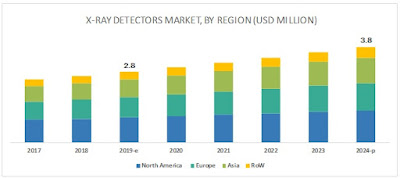X-Ray Detectors Market Insights - Opportunities and Challenge
Market growth is largely driven by growing public and private investments in digital imaging technologies, declining prices and benefits offered by digital detectors, and reimbursement cuts for analog X-rays. The introduction of wireless X-ray detectors, growing medical tourism in developing countries, and the emerging markets are expected to provide a wide range of growth opportunities for players in the market. On the other hand, the high cost of digital X-ray systems is a major factor limiting market growth.
According to research report the global X-Ray Detectors Market is projected to reach USD 3.8 billion by 2024 from USD 2.8 billion in 2019, at a CAGR of 6.1% during the forecast period.
By
application, the X-Ray Detector Market is segmented into medical,
dental, security, veterinary, and industrial applications. The medical
applications segment is expected to grow at the highest rate during the
forecast period. The growth in this segment can primarily be attributed
to the advancements in medical technology, rising geriatric population,
and the increasing number of orthopedic and cardiovascular procedures.
Download PDF Brochure: https://www.marketsandmarkets.com/pdfdownloadNew.asp?id=7004984
Based
on type, the X-Ray Detector Market is segmented into flat-panel
detectors (FPDs), computed radiography (CR) detectors, charge-coupled
device (CCD) detectors, and line-scan detectors. In 2019, the flat-panel
detectors segment is expected to account for the largest share of the
X-Ray Detector Market. The growth in this market is mainly driven by the
advantages offered by FPD-based portable digital systems (such as
high-quality images, faster scanning, increased patient throughput, and
multiple storage options), their decreasing prices, and the growing
demand for retrofit FPD-based digital X-ray systems.
Opportunity: Rising healthcare expenditure across developing countries
The
rapid economic development and increasing healthcare expenditure in
several emerging countries, such as China, India, Brazil, and Mexico,
are expected to improve access to quality healthcare in these countries.
This is considered a positive indicator for the X-ray detectors market.
The rising incidence of breast cancer and cardiovascular diseases in
these countries is driving demand for various X-ray detector devices and
techniques. Moreover, governments across these countries are focused on
providing modern & advanced healthcare services to larger
proportions of their population and improving reimbursement coverage.
Rapid growth in the per-capita healthcare expenditure and the growing
public demand for affordable healthcare services are driving the growth
of healthcare products (including X-ray devices) across these countries.
This is evidenced by the overall increase in healthcare expenditure.
For example, the healthcare expenditure of India increased from 1.2% to
2.5% of the total GDP from 2019 to 2020. In China, healthcare
expenditure rose from 12.6% to reach ~USD 930 billion, as the government
has raised spending in the healthcare sector amid the COVID-19 pandemic
(Source: Healthcare Asia).
Challenge: Increasing adoption of refurbished x-ray units
Many
hospitals in developing countries cannot invest in X-ray detectors
equipment (such as X-ray detectors units, high-end CT scanners) due to
budget constraints, high equipment costs, and poor reimbursement rates.
However, due to the strong demand for X-ray detectors procedures
globally, hospitals that cannot afford to invest in new imaging systems
opt for refurbished ones. This is because refurbished systems are priced
lower than new systems (40–60% of the price of new equipment). Many
independent suppliers provide high-end refurbished and reused systems at
a significantly lower price.
Request For Sample Pages: https://www.marketsandmarkets.com/requestsampleNew.asp?id=7004984
In 2019, North America is expected to account for the largest share of the X-ray detectors market,
followed by Europe, Asia, and the RoW. The large share of North America
is attributed to factors such as technological innovations, increasing
healthcare spending, availability of venture capital and government
funding, and increasing incidence of chronic diseases in the region.
Contact:
Mr. Aashish Mehra
MarketsandMarkets™ INC.
630 Dundee Road
Suite 430
Northbrook, IL 60062
USA: +1-888-600-6441
sales@marketsandmarkets.com

Comments
Post a Comment